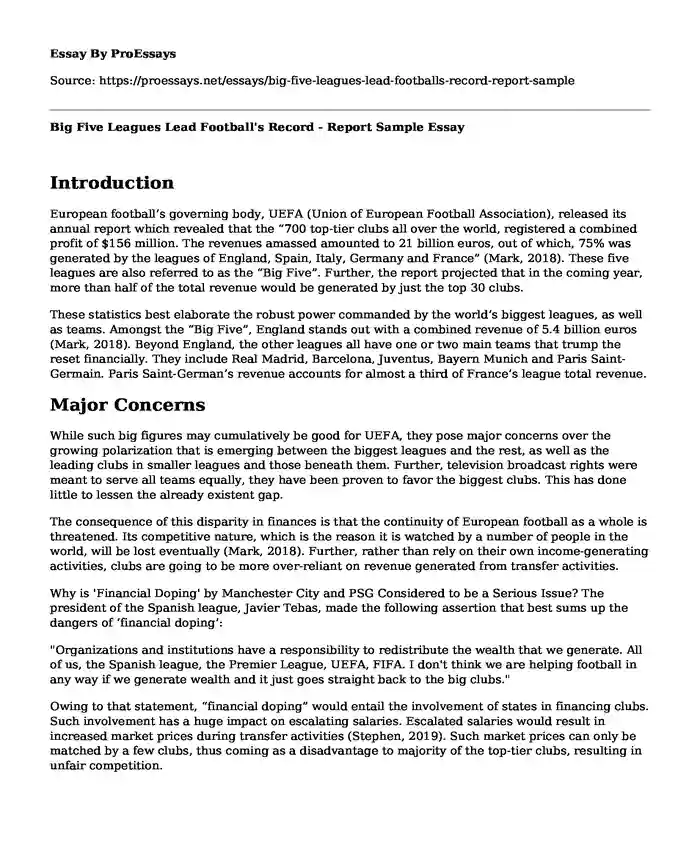Introduction
European football’s governing body, UEFA (Union of European Football Association), released its annual report which revealed that the “700 top-tier clubs all over the world, registered a combined profit of $156 million. The revenues amassed amounted to 21 billion euros, out of which, 75% was generated by the leagues of England, Spain, Italy, Germany and France” (Mark, 2018). These five leagues are also referred to as the “Big Five”. Further, the report projected that in the coming year, more than half of the total revenue would be generated by just the top 30 clubs.
These statistics best elaborate the robust power commanded by the world’s biggest leagues, as well as teams. Amongst the “Big Five”, England stands out with a combined revenue of 5.4 billion euros (Mark, 2018). Beyond England, the other leagues all have one or two main teams that trump the reset financially. They include Real Madrid, Barcelona, Juventus, Bayern Munich and Paris Saint-Germain. Paris Saint-German’s revenue accounts for almost a third of France’s league total revenue.
Major Concerns
While such big figures may cumulatively be good for UEFA, they pose major concerns over the growing polarization that is emerging between the biggest leagues and the rest, as well as the leading clubs in smaller leagues and those beneath them. Further, television broadcast rights were meant to serve all teams equally, they have been proven to favor the biggest clubs. This has done little to lessen the already existent gap.
The consequence of this disparity in finances is that the continuity of European football as a whole is threatened. Its competitive nature, which is the reason it is watched by a number of people in the world, will be lost eventually (Mark, 2018). Further, rather than rely on their own income-generating activities, clubs are going to be more over-reliant on revenue generated from transfer activities.
Why is 'Financial Doping' by Manchester City and PSG Considered to be a Serious Issue? The president of the Spanish league, Javier Tebas, made the following assertion that best sums up the dangers of ‘financial doping’:
"Organizations and institutions have a responsibility to redistribute the wealth that we generate. All of us, the Spanish league, the Premier League, UEFA, FIFA. I don't think we are helping football in any way if we generate wealth and it just goes straight back to the big clubs."
Owing to that statement, “financial doping” would entail the involvement of states in financing clubs. Such involvement has a huge impact on escalating salaries. Escalated salaries would result in increased market prices during transfer activities (Stephen, 2019). Such market prices can only be matched by a few clubs, thus coming as a disadvantage to majority of the top-tier clubs, resulting in unfair competition.
Strict Controls
Clubs in countries that have strict controls on their economies, such as Spain and Germany, would be prejudiced, as they cannot turn to their states to seek finances to pay various salaries. Manchester City and Paris Saint-Germain have been accused in several occasions over being funded by Gulf regimes, that do so at inflated prices (Stephen, 2019). Such income has given them unrivaled power to invest incomparably in their squads. For example, Paris Saint-Germain broke the world record transfer fee for a single player, when they purchased Neymar from Barcelona, for a reported 222 million euros (Stephen, 2019). Manchester City on the other hand hold the record for the most expensive assembled squad, totaling up to over one billion euros. Consequently, both teams have enjoyed unparalled success in their respective leagues with Paris Saint-Germain having won six of the eight league titles since 2011, while Manchester City have won four league titles in ten years (Stephen, 2019).
Conclusion
In contrast with sports in the U.S., i.e., NFL, National Basketball Association (NBA), National Hockey League (NHL), and Major League Baseball (MLB), while the worst performing teams in the league are not allowed to stay, they are rewarded robustly with revenue sharing, as well as top picks in the following year’s draft, to aid in their improvement (Tom, 2018). As such, they do not have to do much to improve themselves, or even spend any of the money, as they are being given top picks in the draft. The situation is way different in Europe. It is almost like ones the teams are relegated, they are forgotten, and left to salvage themselves (Tom, 2018). They face more difficulty in rebuilding since they lose majority of their best players, and the revenue in the lower leagues is not as lucrative as those in the higher league.
Works Cited
Mark, M. (2018, December 15). UEFA wary of growing wealth gap among European clubs. Retrieved September 09, 2020, from
https://www.chicagotribune.com/90minutes/ct-90mins-uefa-wary-of-growing-wealth-gap-among-european-clubs-20180117-story.html
Stephen, L. (2019, September 04). Study confirms huge wealth gap in European soccer. Retrieved September 09, 2020, from
https://www.si.com/soccer/2019/09/04/uefa-european-wealth-gap-big-five-leagues
Tom, J. (2018, July 13). Ironically, European soccer is more capitalist than American sports. Retrieved September 09, 2020, from
https://www.washingtonexaminer.com/opinion/ironically-european-soccer-is-more-capitalist-than-american-sports.
Cite this page
Big Five Leagues Lead Football's Record - Report Sample. (2023, Nov 25). Retrieved from https://proessays.net/essays/big-five-leagues-lead-footballs-record-report-sample
If you are the original author of this essay and no longer wish to have it published on the ProEssays website, please click below to request its removal:
- Essay on American Politics Synthesis
- Essay Sample on Importance of Football
- Case Study on Leo and Julie Retirement Plans
- Essay on Governing Arrangements & Political Will: Key to US Urban Development
- Paper Example on Canada: A Model of Stability and Rule of Law
- Research Paper on Exploring Investment Options for HNW Clients: Strategies & Benefits
- Free Essay Example on Breast Cancer







